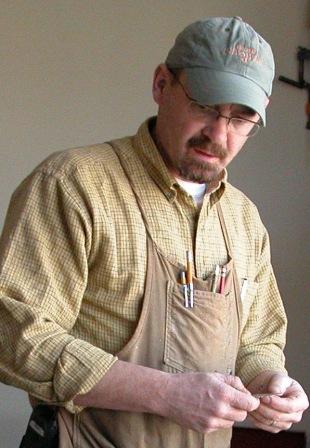
By far the easiest, cheapest, and most numerous frames that I make are made out of MDF. Medium-density fiberboard is an engineered wood product made by breaking down softwood into wood fibers and combining the fibers with wax and a resin binder, and forming the panels by applying high temperature and pressure. It is a building material similar in application to plywood but made up of separated fibers, not wood veneers. It is denser than normal particle board. MDF has a homogeneous structure with uniform texture and properties throughout.There are no identifiable grains or knots seen at the edge, end or face, nor any internal voids or pits or variation in surface hardness. MDF can't be stained or colored like traditional wood so it must be painted. Also, it could be gilded; work I've done on steeples and something I wish to apply to picture frames, but I have yet to try it.
MDF is highly machinable so just about any profile you can machine may be incorporated into the picture frame. It can also be glued together face to face and machined so that profiles thicker than 3/4 can be obtained. In this simple finished example, the frame is about 6 inches wide with a rounded inside and outside. The inside is 1/2" and the outside 1/2" and 3/4" creating a type of torus or thumb. See figure 2. (The painting is by Tammi and is of Bridger sleeping. One of his toys, a large praying mantis, contrasts innocence with impending and inherent danger. There was a lot of light scatter on the painting so the picture isn't the best.)
To create the overall profile I start by ripping 8' runs of the flat sections to the desired width of the frame . Due to weight and cost savings I generally make the flat sections out of 1/2" MDF. I then mill up the various profiles from smaller rips of either 1/2', 3/4" sheet or some glued up combination and then apply the milled profiles to the 8' sections. This effort often results in the use of quite a few clamps along with some creative clamping. After the glue drys I then cut the miters and assemble.
The Miter Sled
The miters must be absolutely precise. The best way to saw wide miters is to build a miter sled for use on the table saw. Of course the wider the miter, the more a fraction of a degree shows. With a picture frame this error is multiplied by eight. This means that a error of 1/8 of a degree will produce, in a picture frame, three tight miters and a miter that is off one degree!
Painted MDF tends to show every flaw, and I mean every little flaw. So, exactitude is critical. The miter sled setup must therefore be exact. A miter sled is built like a typical sled with the guides for the miters fixed at the correct angles rather than having a back fence. The best way to accomplish an exact 45 degree angle is to assemble the sled minus the miter guides and run the sled up and down the table saw with the blade down and off. Mark the front and back of the sled at the exact center of the blade. Draw a line which connects the two points. You now have the exact center line of the blade. Determine the location of the "point" of the miter on the sled along the center line. This line marks the shortest part of the cuts mites, which will be on both the left and right miters. With a beam compass set the one point at the intersection of the back of the sled and the center line. (I suggest using a point rather than a pencil) Stretch the compass to the predetermined point of the miter and scribe a radius. An exact 45 degree angle is now described by the two points which intersect the back of the sled at the outside of the radius and the miter "point". (The rear of the sled must be exactly perpendicular to the center line to achieve accuracy. If not, scribe a perpendicular line to the center line. The further apart all of these line and points are, the greater the accuracy of the setup. The easiest way to accomplish a perpendicular line is to again use your compass. Move the center point along the center line a short distance and increase the diameter. Scribe two points where this radius meets the original radius. Connect these two points with a straight line and you have two perfectly perpendicular lines. ) Next, prepare absolutely straight miter guides for the sled. It is beneficial to cut a small dado along the length of the guide at the intersection of the sled and the guide so any sawdust or other obstruction is prevented from affecting the angle of the miter. Attach the miter guides, add some clamps to keep things in place and you're done.
Three Examples
Finishing
After cutting the miters and glue-up the frames must be painted. Before painting I run a very tight bead of caulk around each milled section. This keeps any small cracks from showing and creates a more professional finish. I always spray paint the frames flat black and then spray a light coating of satin varnish. This keeps the frame from looking flat and also too shiny.







not too sure what is taking place,but i sure hope this finally goes through, thank you for sharing your blog with me. I have enjoyed it.
ReplyDeleteThe reason behind this comment is your lovely woodwork.
You pay such attention to detail.
Do you sell any of your creations?
Again thank you for sharing, Tammi and I went to the same High School, but we were not close (youth).
You both are very talented.
Veronica Smith
Veronica,
ReplyDeleteThanks - I may sell one of the ones I'm working on now. Glad you enjoyed the blog.